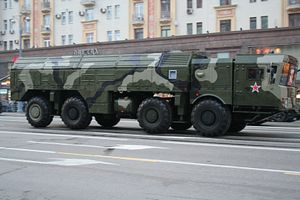The majority of missile units within the Russian Ground Forces (RGF) have been retrofitted with the short-range nuclear-capable road-mobile 9K720 Iskander-M (NATO reporting name SS-26 Stone) ballistic missile system as the obsolete Soviet-era OTR-21 tactical missiles are being phased out, the head of the RGF, Colonel-General Oleg Salyukov, told reporters on February 22, TASS news agency reports.
“Work continues in the ground forces to rearm military units and formations with the modern types of armament and military hardware. The ground forces’ missile formations are switching over in a planned procedure from the Tochka-U tactical missile complex to the Iskander-M system. As of today, over 80 percent of missile formations have received the new missile systems,” Salyukov said.
The general noted that two more missile units will be rearmed with the Iskander-M ballistic missile in 2017. Separately, Russian Defense Minister Sergei Shoigu announced on February 22 in the lower house of the Russian Parliament that the RGF will complete the switch to the new ballistic missile system by the end of 2017.
“We’ll complete the rearmament and the switchover to Iskander complexes across the country this year. Some of our [radar] stations are on experimental combat duty today but this year all of them will switch over to the mode of combat alert and we’ll fully cover the entire perimeter, all the country’s radar field for missiles of all types, all trajectories, including ballistic paths,” the defense minister said.
As I reported previously (See: “Russia Test Fires Nuclear-Capable Ballistic Missile”), the RGF last test fired an Iskander-M missile in August 2016 during a large-scale military exercise in Russia’s Far East. “The launch was carried out from a training site in the Jewish Autonomous Area. The missile hit a target at a proving ground in the Amur region 300 kilometers away,” a RGF spokesperson announced at the time.
In February 2017, RGF reportedly fired four Iskander-M ballistic missiles against targets in Syria’s Idlib province, according to U.S. media reports. As I noted last year:
The Iskander-M missile purportedly was inducted into service already in 2006. Rumors emerged in March and April 2016 that the missile had been deployed to Syria. The missile was also publicly displayed during this year’s May 9 Victory Day parade.
The two-stage solid propellant missile allegedly has a range of 400-500 kilometers (310 miles) and its [nuclear-capable] single warhead can carry a payload of about 700 kilograms. It has been specifically designed to evade Western missile defenses and reportedly is able to operate in temperatures ranging from -50 to 50 degrees Celsius (-58 to 122 degrees Fahrenheit).
The tactical ballistic missile can be deployed to destroy a host of different targets including missile and multiple launch rocket systems, artillery batteries, as well as command posts and communications centers. It can be armed with variety of different warheads for that purpose. The total number of 9K720 Iskander-M missile systems currently deployed in the RGF is estimated to be over 100. A shorter-range export variant of the 9K720 Iskander-M missile system has been offered to China, India, and South Korea. However, only the domestic version of the missile can be armed with a nuclear warhead.

































